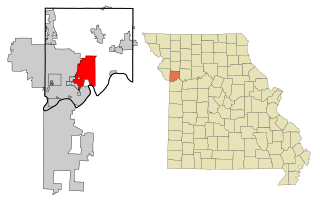
William Jewell College is a private, four-year liberal arts college of 813 undergraduate students located in Liberty, Missouri, United States. It was founded in 1849 by members of the Missouri Baptist Convention and endowed with $10,000 by William Jewell. Another founder was Robert S. James, a Baptist minister and father of the infamous Frank James and Jesse James. It was associated with the Missouri Baptist Convention for over 150 years until its separation in 2003 and is now an independent institution. Although the college is accredited by the Higher Learning Commission, it was placed on probation in late 2017.

East Campus is a neighborhood of Columbia, Missouri directly east of the University of Missouri and downtown Columbia. The area contains historic residential property as well many Greek student organizations houses. The district contains parts of Stephens College, the Boone Hospital Center's campus and the historic Lee Street Deli. It developed between about 1895 and 1945, and includes representative examples of Tudor Revival, Colonial Revival, and Bungalow / American Craftsman style architecture.
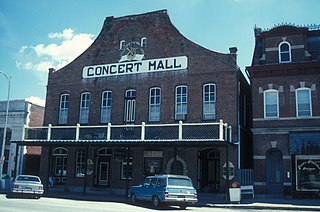
Hermann Historic District is a national historic district located at Hermann, Gasconade County, Missouri. The district encompasses 360 contributing buildings, 4 contributing structures, and 3 contributing objects in the central business district and surrounding residential sections of Hermann. The district developed between about 1838 and 1910, and includes representative examples of Greek Revival and Classical Revival style architecture. Notable buildings include the Eitzen House (1855), Potnmer-Gentner House (1848), Hermann City Hall (1906), Strehly House (1845), Concert Hall (1877), The German School (1871), and Gasconade County Courthouse (1896).
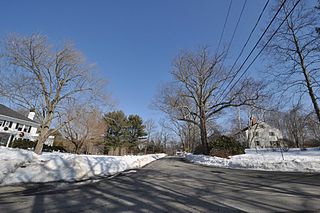
The Jewell Town District of South Hampton, New Hampshire, encompasses a colonial-era industrial village with a history dating to 1687. It is centered at the junction of West Whitehall and Jewell Streets, which is just south of a bend in the Powwow River, the source of the power for the mills that were built here. The area was settled in 1687 by Thomas Jewell, and by the early 19th century included a variety of mills as well as a bog iron works. The district now includes only remnants of its industrial past, and features a collection of 18th and early-19th century residential architecture. The district was listed on the National Register of Historic Places in 1983.

The Auchentoroloy Terrace Historic District encompasses a residential district southwest of Druid Hill Park on the northwest side of Baltimore, Maryland. It is roughly bounded by Auchentoroly Terrace, Reisterstown Road, Liberty Heights Avenue, and Fulton Avenue. This area was developed between 1895 and 1911 with a series of large and fashionable townhouses, mainly in the Renaissance Revival style. Development was begun by the heirs of John Morris Orem, and largely finished by the Auchentoroloy Corporation, which acquired land not developed by the Orems.

Liberty Residential Historic District is a national historic district located at Liberty, Union County, Indiana. The district encompasses 67 contributing buildings in a predominantly residential section of Liberty. It developed between about 1841 and 1920 and includes representative examples of Greek Revival, Italianate, Queen Anne, Colonial Revival, Bungalow / American Craftsman, and Ranch style architecture. Notable contributing buildings include the First Presbyterian Church (1889), Union County Public (Carnegie) Library (1915), John S. Nixon House (1879), John B. Macy House (1876), and Union County Seminary (1841).

Frank Hughes Memorial Library is a historic library building located at Liberty, Clay County, Missouri. It was designed by the architectural firm Wight and Wight and built in 1940. It is a one-story, rectangular Classical Revival style brick building. It has a gable roof with a wide elaborate cornice. It features a flat-roofed portico feature a wide, simple wood entablature topped with a rooftop balustrade.
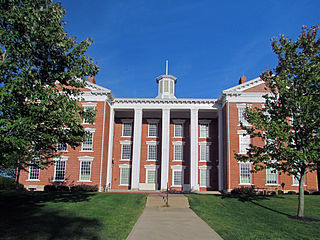
Jewell Hall is a historic building located on the campus of William Jewell College at Liberty, Clay County, Missouri. It was built between 1850 and 1853, and is a three-story, modified "H"-plan, Classical Revival style brick and Missouri limestone building. The building measures 120 feet in length and 66 feet in width. It features a colonnade of square columns which spans a recessed, central portico. The interior of Jewell Hall was completely remodelled in 1946-1948.

Arthur–Leonard Historic District is a national historic district located at Liberty, Clay County, Missouri. It encompasses 36 contributing buildings in a predominantly residential section of Liberty. The district developed between about 1868 and 1946, and includes representative examples of Greek Revival, Queen Anne, Prairie School, and Bungalow / American Craftsman style residential architecture.

Dougherty–Prospect Heights Historic District is a national historic district located at Liberty, Clay County, Missouri. It encompasses 139 contributing buildings in a predominantly residential section of Liberty. The district developed between about 1850 and 1946, and includes representative examples of Greek Revival, Queen Anne, Tudor Revival, Prairie School, and Bungalow / American Craftsman style residential architecture.

South Liberty Courthouse Square Historic District is a national historic district located at Liberty, Clay County, Missouri. It encompasses nine contributing buildings in the central business district of Liberty. The district developed between about 1875 and 1942, and includes representative examples of Classical Revival, Late Victorian, and Modern Movement style architecture. Notable buildings include the Clay County Courthouse (1935-1936) by Wight and Wight and First National Bank (1923).

Odd Fellows Home District is a national historic district located at Liberty, Clay County, Missouri. It encompasses three contributing buildings, one contributing site, and four contributing structures associated with an institutional home and hospital. The district developed between about 1900 and 1935, and representative examples of Tudor Revival and Jacobethan Revival architecture. The contributing buildings are the Administration Building, the Old Folks Building (1907-1908), and the Old Hospital (1923). Also on the property is the historic Odd Fellows Home Cemetery.

Mt. Memorial Cemetery, also known as The Old Gravevard, is a historic cemetery located on the campus of William Jewell College at Liberty, Clay County, Missouri. It was established about 1828, and contains 554 documented burials. The cemetery is rectangular in plan and measures approximately 140 feet by 435 feet.

The Elms Historic District is a national historic district located at Excelsior Springs, Clay County, Missouri. It encompasses 31 contributing buildings, 1 contributing site, and 7 contributing structures in a predominantly residential section of Excelsior Springs. The district developed between about 1887 and 1963, and includes representative examples of Gothic Revival, Tudor Revival, and Bungalow style architecture. It is anchored by the separately listed Elms Hotel and consists of two historic residential plats: the Central Park and the Elms Addition.
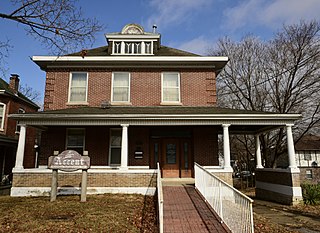
Broadway–Dunklin Historic District is a national historic district located in Jefferson City, Cole County, Missouri. It encompasses 23 contributing buildings in a predominantly residential section of Jefferson City. The district developed between about 1885 and 1915, and includes representative examples of Classical Revival, Late Victorian, and Colonial Revival style architecture. Notable buildings include the former Broadway School (1904).
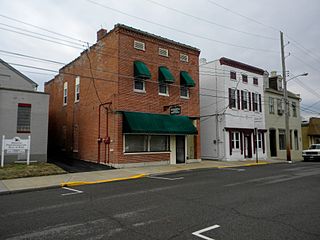
Tibbe Historic District, also known as the Lustigestrumpf Historic District, is a national historic district located at Washington, Franklin County, Missouri. The district encompasses 23 contributing buildings in a predominantly residential section of Washington. The district developed between about 1857 and 1941, and includes representative examples of Queen Anne, Colonial Revival, and Bungalow / American Craftsman style residential architecture.

Stafford–Olive Historic District is a national historic district located at Washington, Franklin County, Missouri. The district encompasses 140 contributing buildings in a predominantly residential section of Washington. The district developed between about 1858 and 1949, and includes representative examples of Queen Anne, Second Empire, Tudor Revival, Colonial Revival, and Bungalow / American Craftsman style residential architecture. Notable buildings include the Jos. Rumme House, Chas Haupt House, Louis Horn House, F. R. Pelster House, Hydecker House, Stephen Filla House, Chas. Kopp House, Hy. Thias Honse, and William Pace House (1929).

The Fenelon Place Residential Historic District is a nationally recognized historic district located in Dubuque, Iowa, United States. It was listed on the National Register of Historic Places in 2015. At the time of its nomination it consisted of 218 resources, which included 171 contributing buildings, two contributing structures, one contributing site, 43 non-contributing buildings, and one non-contributing structure. The residential area that makes up the district is located on a plateau located directly above the Mississippi River Valley. This was the first bluff-top neighborhood in Dubuque that established elevator service. The first Fenelon Place Elevator, listed on the National Register in 1978, was completed in 1894. Early houses on the plateau were small cottages built by lead miners. They were replaced by large houses that were built in two periods. The first period at the end of the 19th century saw houses built in the Italianate, Gothic Revival, Second Empire, and Queen Anne styles. House in the second period in the beginning of the 20th century were largely built in the Classical Revival and Tudor Revival styles.

North Third Street Historic District is a national historic district located at Louisiana, Pike County, Missouri. The district encompasses 61 contributing buildings, 1 contributing site, and contributing structure in a predominantly residential section of Louisiana. It developed between about 1843 and 1935, and includes representative examples of Greek Revival, Gothic Revival, Italianate, Queen Anne, Colonial Revival, and Bungalow / American Craftsman style architecture. Located in the district are the separately listed Louisiana Public Library and Luce-Dyer House. Other notable buildings include the William C. Hardin House, James H. Johnson House, Edward G. McQuie House, St. Joseph's Catholic Church (1874), and Frank Boehm, Jr. House.

